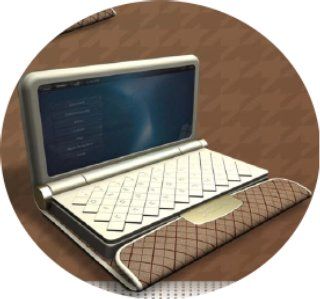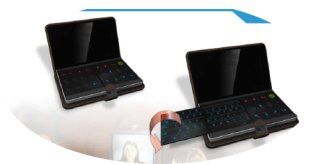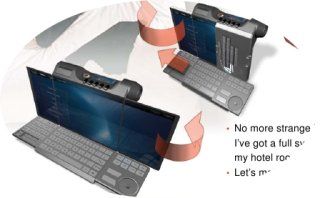At the Computex trade show in Taiwan last month, VIA held a special event known as the VIA Technical Forum. It was the 7th year of presentations by guest speakers in the areas of industry that VIA are focusing on. Unfortunately we weren’t able to get there for the event but we’ve been analysing the presentation slides that are available on the VTF website and here’s an overview.
The most interesting presentations for the ultra mobile PC market were in the dedicated Ultra-Mobility Technology presentation track. Here’s a run-down of the main presentation content.
Rob Enderle of the Enderle group has already made some good commentary about UMPCs in the video interviews he gave to Bjorn Stromberg of ultramobilelife and he started the sessions with a look at the possible future of Ultra Mobile Devices. His presentation is available here and it shows some important points about the opportunities for the UMPC. Video and IPTV are mentioned and we have to agree that IPTV and IPTV contracts could be both an attractive application and a good way to sell the devices at subsidised prices. There’s also a nice summary of the Hardware targets which mentions ‘arms length GUI’, ‘good sync’, ‘edgy design’, ‘hybrid or flash drives’ and ‘4 hours battery life’.
Good sync is an interesting point. There is no specific syncing solution with the current versions and this is an area where someone could step in with a nice UMPC-optimised software solution.
Epan Wu, Deputy Director of the Systems Platform Division at VIA gave a presentation (available here ) about VIA’s ultra-mobile platforms with an emphasis on battery life and ‘x86 in the palm of your hand.’ Epan has also a slide showing the ‘PC-Phone’ concept which, to me, looks like the UMPC. Is this a new VIA expression for the same devices? Becuase of VIA’s close relationship with HTC, producers of 70% of the worlds Windows-mobile based smartphones, it might have something to do with their common direction that they’ve chosen to include the word ‘Phone.’ We’ve tipped it before. HTC and VIA are well-positioned to bring UMPC’s to the market via mobile carriers.
There’s an interesting slide on battery life which highlights the processor, the BIOS and the LCD display. Moving to LED backlighting could really help save a lot of power. The second part of the presentation is about Adaptive Power Saver technology which looks like an interesting attempt to bring some control in through the BIOS to achieve very rapid state changes for the CPU. There are also a few slides about ‘John’ the PC in a package that will save space and power in UMPC’s. It contains the CPU, Northbridge, GPU, Southbridge, Video hardware and Encryption engine all in one very small package.
The next presentation to look at is from Dennis Luo, Project Manager for Ultra-Mobile PC’s at Microsoft. The first part of the presentation (available here ) is an overview of what Dennis calls ‘UMPC2006’ Thats this years spec. Now this answers a question. What happens to the ultra mobile PC spec when technology moves on. Its clear now that UMPC2007 will be something a bit different to this years model. To be a UMPC2007 version, a device must be able to support Windows Vista, use LED backlight technology, maintain the current 1Ghz class CPU (but reduce power.) and reduce thickness and weight to sub 700gm. The device should also support WWAN technologies for an always connected experience. There are some ‘possible’ scenarios thrown in too like solid-state disks, integrated LCD touch panels (not the multi-part panels that are used today.) and passive cooling. The many uses of the word ‘possible’ indicates that the specs haven’t been set in stone yet. The last part of the presentation talks about software development for the ultra mobile PC which is going to be very important. Those of you thinking about software developement for the ultra mobile PC will want to take a good look at that part of the presentation.
Next to present was Dr. Gary B. Bronner, Distinguished Engineer at IBM Corporation. IBM are responsible for fabricating the VIA-C7 chips and Gary shows a lot of detailed information about the Silicon on Insulator (SOI) process that was used. Its a very technical presentation but shows how the process has advantages in low-voltage setups. The presentation is available here .
Finaly in the Ultra Mobile Computing track was the presentation of ultra mobile PC design concepts and innovation by Kris Verstockt, Executive Director of Cre8 Inc. (available here ) and it contains some great concept products that could be possible in the ‘near future.’ The company took criteria like ‘user focused design’, ‘user may not want to give up keyboard’ and ‘avoid swiss knife effect’ and assumed that becuase of the way things can be target-marketed globally on the internet , that there is the possibility to market a niche product and hit enough potential customers to make it worthwhile. Its a concept that we believe in at Carrypad but not one that Microsoft appears to believe in. If they believed in it then they wouldn’t be loading Windows XP onto the devices, they would be tailoring a multiple versions of Windows (as a side-note, why did MS never produced a ‘kids edition’ of their Windows software?)
You should read the whole presentation if ultra mobile PC design is something you’re interested in but here’s a few snippets.
The black ‘executive’ is a hybrid ultra mobile PC and paper notepad with fold-out keyboard, the ‘waletino’ is an ultra-mobile notebook pc in a purse-style casing and the rather cool ‘holiday mate’ is looks like a video cam but has a three-section fold-out screen and fold-out keyboard.



Another interesting point thats made at the end of this presentation is that Cre8 Inc. believe that keyboard, processor and keyboard enhancements are being worked on and won’t be a problem but battery technology will be what holds ultra mobile PC progress up.
Outside the ultra mobility track, there were a few other presentations worth looking at. The presentation from Timothy Chen of VIA was promoting digital media as part of VIA’s drive to become a media content brand through it’s ‘OnDemand’ service. HTC, the sister company to VIA have also deviced to become a brand now and it adds weight to the thought that they might work really closely together in the future on this. VIA and HTC as a hardware, product and media company.
Finally lets mention the AMD presentation . Not becuase of it’s content but because it was a VIA forum. What are VIA and AMD up to together? There must be something going on there. Will VIA move away from IBM and use AMD fabs? Who knows!










